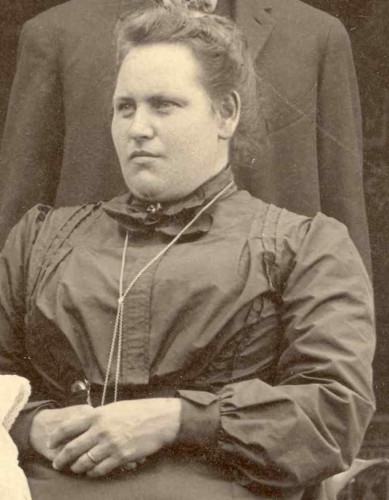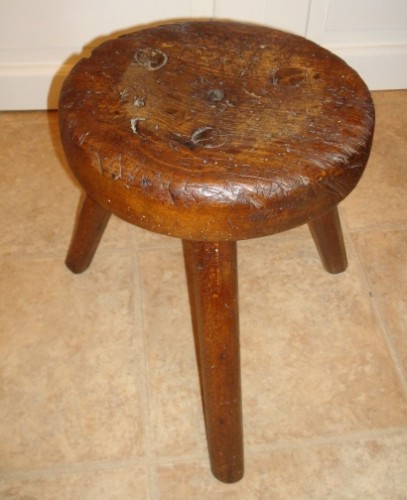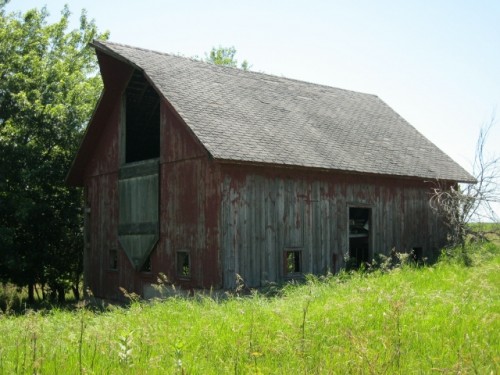Ella V. Daniel Roberts- A Day in the Life of a Farm Wife, Part 1

Roberts Family , Daniel Family (Click for Family Tree)
A farm wife’s life revolved around the simple rhythms of the seasons, the crops, the animals, and her family. Her youngest daughter, Edith Roberts Luck, later wrote stories and letters to her family, detailing the people she loved. She particularly loved her mother, Ella V. Daniel Roberts:
I know she lived the life she loved and she was happy… She worked so hard with Dad [George Anthony Roberts] to pay for these acres. I am sure she enjoyed it all. I never did think she enjoyed the new house as she did the home place. It was just too fancy.
Although a large woman and short, that did not slow her down with her farm work. Edith wrote:
I have heard women say; “No one can move as fast as Ellie Roberts.” “She can get more done in less time than any of us.”
Milking was a constant chore on the farm- it HAD to be done twice daily. Ellie Roberts used a small three-legged stool- Edith wished she still had it, and never could believe that her large mother was able to use such a small stool for milking.
Mother milked too. I can see her coming up the grade from the barn carrying two big buckets of milk. The cats following along behind ready to lap up the foam if she had to get her second wind to continue on to the milk house which was just east of the kitchen porch. Imagine two hundred pounds and working like that.

Writing about the horses and cows, Edith remembered:
The barn was warm and noisy with their movement and eating. We would go up in the hay mow and throw [hay] to put in their mangers. Brother helped mama milk, and I would have to go Protesting to the house, because I couldn’t be in the cow-barn where they were milking.
Brother (George Anthony Roberts, Jr.) … did the separating too. Before we had the separator mother skimmed the cream off the top of the tall cans. In the winter we sold butter and in the summer cream.
Chickens were usually the responsibility of the wife and sometimes children as they got older. Feeding them and gathering eggs was a chore done every day as well.
There were eggs to gather and mother always raised her chickens from eggs out under setting hens. She never had an incubator. I don’t know [w]hy.
I was scared of those old hens. They could really peck you. I can see those little chickens breaking out of the shells and Mother going along and helping some if they were having a hard time. That was why she was so mad at the two snakes that were twined around each other when she was carrying water to the hogs that were so hot on a summer day. She discovered these snakes on the way to the hogs and she set down the water buckets and took a hoe and killed the snakes. Nowadays we know bull snakes are good to catch rats etc. But all mother could think of was them getting in her hens nests and eating her eggs that were about ready to hatch or had hatched. You cannot blame her. She was rather a timid person and I was so scared for her.

The animals on the farm required constant attention, and it was all a part of being a farm wife. For Ellie Roberts, even her vacations had to do with farm work:
When she was forty years old and I was ten we had the first vacation I can remember. I can see her now on the scales at the packinghouse we visited. Packing house you say. Yes that was it. Mother said, “She had seen so much stock driven or hauled off the yard she wanted to see what happened to them.” This was in Council Bluffs. We visited an Aunt Net. Well your grandmother couldn’t take it. I saw those squealing hogs being dipped into hot water and I was sick, so Aunt Net took me away. But mother, she stayed thru the whole procedure. Where they took care of the cattle was not so bad I guess.
To be continued…
Notes, Sources, and References:
1) Milking stool- Creative Commons Attribution-Share Alike 3.0 Unported license via http://commons.wikimedia.org/wiki/File:Tabouret_pour_traire.JPG
2) Excerpts in green are from letters and stories written by Edith Roberts Luck. They are protected under copyright law since she wrote them in the 1970s and 80s, so may not be published or posted elsewhere. Family members may request permission to republish for non-profit use; please use our contact form.
Please contact us if you would like higher resolution images. Click to enlarge images.
We would love to read your thoughts and comments about this post (see form below), and thank you for your time! All comments are moderated, however, due to the high intelligence and persistence of spammers/hackers who really should be putting their smarts to use for the public good instead of spamming our little blog.